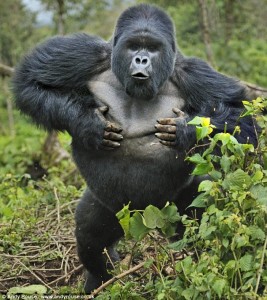3. Gestural Communication in Animals
There are numerous studies that support that non-human primates, who are of closest relation to humans are able to gesture as part of their communication systems. The pioneering studies of Goodall (1986) and Kummer (1968) observed different gestures used by monkeys and apes.
The studies of gestural communication in apes both in captivity and in the wild reveal the following:
- The use of communicative gestures is common across the species,
- There is considerable variability in gesture repertoire from group to group,
- Gestures are used flexibly in different contexts, depending on the behavior of the recipient.
Gesturing by primates is argued to be partially genetic, with apes performing gestures that are characteristic of their species even without prior observation of the gesture. An evidence of this is the “chest beat”, a display of threat, being performed by two gorillas that have not witnessed the performance of this gesture before (Redshaw & Locke, 1976). Similarly, chimpanzees from peer groups that essentially had no opportunity to observe older conspecific develop many of the same play gestures performed by individuals from a more natural group composition (Berdecio & Nash, 1981). Hence, the Gestural Theory suggests the importance and intrinsicality of gestures in primate communication, holding that gestures were the precursors to language and communication.

3.1 Gestural Repertoires in Non-Human Primates
Pika (2008) explained that primates are able to produce different types of gestures, namely,
- Auditory gestures – dependent on the sound produced
- Tactile gestures – dependent on physical contact
- Visual gestures – dependent on visual information
Gestural repertoires vary depending on the individual’s age, sex and group affiliation. For example, there are at least twenty different gestures observed among siamangs, a group representative of small apes and gibbons. Such gestures include “embrace” and “offer body part”. The production of species-typical gestures may be due to genetic dispositions (Arbib et al., 2008), as chimpanzees from peer groups that had no opportunity to observe older chimpanzees developed many of the same play gestures as individuals from relative groups.
3.2 Monkeys and Apes
Pika’s research (2008) revealed that monkeys are able to notify fellow members in the family. This was determined when one monkey had eye-to-eye close contact with another monkey before moving onto another task. It is possible that the first monkey was emphasizing a point to the other monkey. The research also revealed that monkeys were able to attract a fellow monkey’s attention by conducting the action of slapping the ground. Different species of monkeys have also been found to use different varieties of manual gestures and postures, varying as a function of social rank and contexts (Maestripieri, 1999).
Pika (2008) also showed that apes produced communicative gestures that were specific to its species. Ogden & Schildkraut (1991) suggested that gorillas are able to produce a combination of auditory and visual gestures. Some specific gestures include the splash display (Parnell & Buchanan-Smith, 2001) and the hand clapping (Fay, 1989). Arbib et al. (2008) revealed that gorillas in captive are able to utilize a variety of at least 30 different tactile, visual and auditory gestures.
A recent study conducted by the University of St Andrews also records up to 66 different gestures that show how chimpanzees communicate, such as the tapping of another chimpanzee to indicate ‘stop that’ and the raising of an arm to indicate ‘give me that’ (Brooks-Pollock, 2014). Even with such a “gestural lexicon” on chimpanzees created, many variances were observed in the communication of a certain meaning, suggesting that different groups of monkeys develop their respective sets of gestural repertoires. Nonetheless, Hobaiter & Bryne (2014) explained that just with human words, some gestures by the chimpanzees have several senses, but the meanings remain the same irrespective of who uses them.
This information on the gestural system in non-human primates suggests the primitive origins of gestures as a form of communication even with the absence of speech, providing additional insight to the gestural-first theory in the study of evolutionary linguistics, particularly in the recent years.
Here’s a video that shows how the “chest beat” (as performed innocently by the little girl) has agitated a gorilla, due to the gesture signifying an act of dominance and aggression: